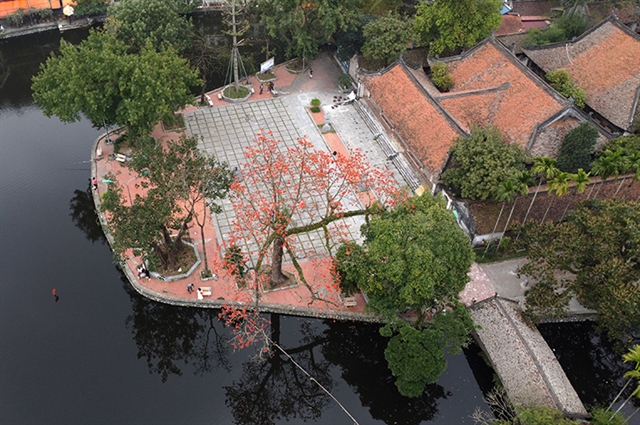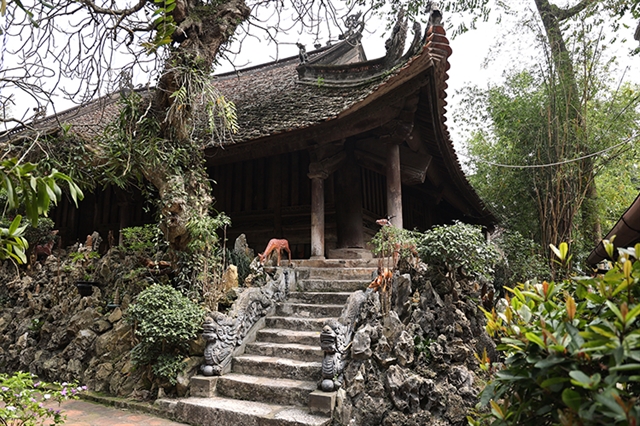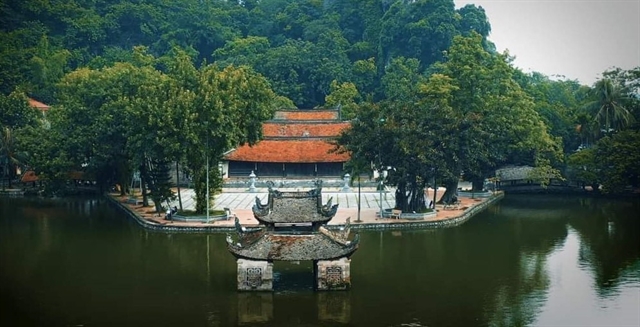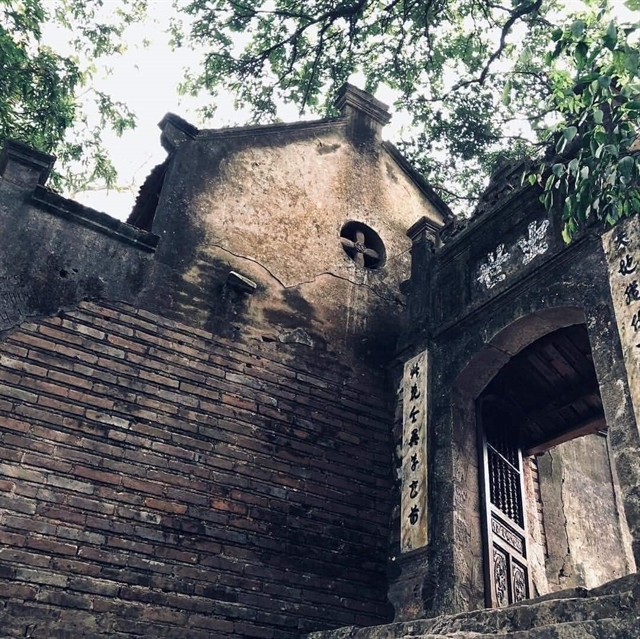Situated at the foot of an arc-shaped limestone mountain overlooking the plains of Sài Sơn Commune, the pagoda stands among picturesque villages in a mesmerising mountainous landscape akin to a realm of enchantment.

WORK OF ART: Thầy Pagoda resembles a captivating landscape painting. — VNS Photo Lê Phú
Thanh Nga
Thầy Pagoda, with a history spanning over 1,000 years, is renowned as the foremost relic complex of ancient Đoài, resembling a captivating landscape painting.
For ages, Xứ Đoài encompassed a vast territory to the west of Thăng Long imperial city, and it is revered as the birthplace of ancient Vietnamese civilisation. It encompasses Sơn Tây Town as well as the districts of Quốc Oai, Thạch Thất, Ba Vì and Đan Phượng.
Venturing southwest along the Láng - Hòa Lạc Highway for approximately 25 kilometres, we arrived at Thầy Pagoda in Sài Sơn Commune, Quốc Oai District, Hà Nội. The pagoda derives its name from the deep reverence bestowed upon Từ Đạo Hạnh, a Zen master from the Lý Dynasty who arrived here in the late 11th century.
He served as both a teacher imparting literacy to the locals, and a healer, as well as a mentor in traditional folk practices such as water puppetry. Consequently, the people of the area held him in great esteem, referring to his place of practice as Thầy (Teacher) Pagoda.
The pagoda was constructed in the architectural style of the Lý Dynasty, featuring the distinctive Tam letter formation comprising three parallel pagodas erected on an elevated foundation of green stone clusters.

STANDING PROUD: The Thượng Pagoda is located separately from the Hạ and Trung pagodas. — VNS Photo Lê Phú
Not only does the pagoda exude beauty through its natural landscape, but it also possesses an inherent harmony with feng shui principles. The architectural design bestows an ancient and sacred elegance upon the temple.
Situated at the foot of an arc-shaped limestone mountain overlooking the plains of Sài Sơn Commune, the pagoda stands among the picturesque villages of Đa Phúc and Thụy Khuê, a mesmerising mountainous landscape akin to a realm of enchantment.
According to local elders, prior to the establishment of the pagoda by Zen master Từ Đạo Hạnh, there was a lake at the mountain's base, with a mound protruding like a dragon rising to drink from its waters. The people of that time constructed a larger mound to accommodate the majestic pagoda.
The outer court serves as a place of worship for monks and nuns, as well as a venue for teaching and preaching, commonly referred to as the pre-sacred house or the Hạ Pagoda. The middle court is dedicated to the veneration of Tam Bảo, housing the middle hall or the Trung Pagoda. The innermost court houses three statues representing the reincarnations of Zen master Từ Đạo Hạnh, within a grand and resplendent palace known as the Thượng Pagoda. Temples and steeples are also interspersed along the mountain ascent.
Encircling the pagoda are two corridors, positioned behind the bell tower and the drum courtyard.
In front of the pagoda is a vast courtyard overlooking Long Chiểu Lake, forming the jaws of a dragon. Two red cotton trees once grew here, symbolising dragon's teeth, although they have since withered, giving way to banyan trees.
From this courtyard, two bridges, Nhật Tiên Kiều and Nguyệt Tiên Kiều, extend to both sides, resembling dragon's beards. These two bridges were constructed by Phùng Khắc Khoan in 1602.

HISTORIC: Thầy Pagoda has a history spanning over 1,000 years. — VNS Photo Kim Thúy
Additionally, there is a Cao Pagoda atop the mountain, and it is believed that the Phật Tích Cave behind the temple served as the place where Từ Đạo Hạnh transcended his mortal form to be reborn as King Lý Thần Tông.
In front of the Thầy Pagoda courtyard, the Thủy Đình building emerges like a lotus blossoming on the water's surface, featuring gracefully curved roofs that enhance the site's ancient allure. Particularly in March, the ancient red cotton tree in front of the temple blooms with red flowers, painting a corner of the sky, providing a delightful scene for pilgrims to admire.
The pagoda also shares a close connection with the cave complex, offering a diverse array of experiences during festivals.
Visitors to Thầy Pagoda have the opportunity to explore other remarkable attractions such as Cắc Cớ Cave and the Thầy Pagoda Festival.
Cắc Cớ Cave, a natural cave likened to a miniature Sơn Đoòng but near Hà Nội, holds immense spiritual significance and mystery. Not only does it boast a unique landscape, but it also harbours numerous enigmatic spiritual values.

GREAT GATE: The ancient gate leading to Một Mái Pagoda, a small pagoda located in the Thầy Pagoda relic complex. — VNS Photo Kim Thúy
To fully venture into Cắc Cớ Cave, visitors must navigate a path strewn with sharp and jagged rocks. The cave's depths are shrouded in darkness. However, upon conquering the cave's challenges, visitors will find themselves rewarded with an experience both extraordinary and awe-inspiring, surrounded by breathtaking scenery.
The traditional festival of Thầy Pagoda takes place from the 5th to the 8th of March on the lunar calendar. This vibrant festival encompasses traditional rituals and folk activities. Visitors have the opportunity to join performances, wrestling matches, water puppetry shows, mountain climbing, and various other folk games.
Thầy Pagoda stands as a testament to the continuous flow of historical and cultural heritage. It was officially recognised as a special national relic in 2015. — VNS